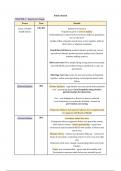Summary
Summary Option 34.2: Poverty, public health and the state in Britain, c Notes
- Course
- Institution
This document has a timeline of events, separated in topics like the exam in A* style standard. It is coherent and easy to understand summary of the key events and time periods within Paper 3 history, separated into each chapter.
[Show more]



